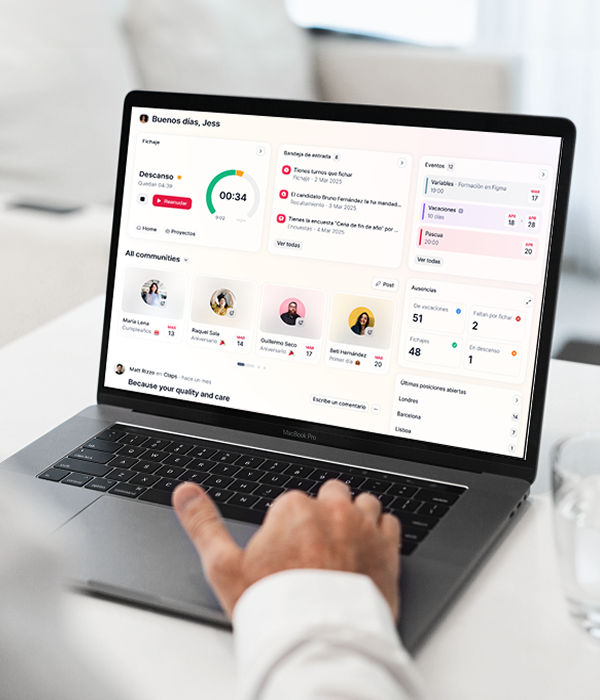HR software, short for Human Resources software, is a powerful asset that automates teams’ HR processes. It serves as an essential tool for businesses of all sizes looking to streamline and transform the way they approach their HR tasks. Don’t fall behind the competition and discover the benefits HR software can offer your team. In this guide, we’ll explore everything you need to know about HR software, including types, key features, benefits, and our top recommendation.
Find out how to embed people analytics into your HR operations. Download our latest report.
What is HR Software?
HR software is a digital solution that automates and centralizes HR functions. This includes employee data management, the hiring process, and onboarding. Even more critical processes such as time tracking, payroll processing, and performance management can be automated with the right HR software. This way your core HR functions are centralized and managed from a single system. By automating these repetitive, manual tasks into a unified platform, HR teams can focus on strategic initiatives that support team and business growth.
Digitizing SMBs with HR Software
As technology advanced, HR software underwent significant transformations. The integration of cloud computing and internet connectivity revolutionized the HR industry, enabling cloud-based HR software. For the first time, businesses could access their HR systems securely from anywhere, thanks to cloud adoption. This encouraged effortlessly remote work and collaborative processes. More recently, HR software has evolved even further – allowing users to customize their platforms to cater to different businesses’ specific needs.
Modern HR software include time and attendance management, payroll, employee onboarding, employee performance tracking, and more. This automates repetitive and time-consuming tasks freeing up HR teams to focus on making meaningful impact. The shift towards AI-driven features, analytics, and data-driven insights has further enhanced HR software’s capabilities, empowering organizations to make informed decisions about their workforce.
Key Features & Benefits of HR Software
HR software comes packed with a range of features that cater to human resource management needs. HR software is designed to simplify administrative tasks, boost employee engagement, and provide valuable insights for HR professionals and decision-makers.
| Features | Benefits |
| Employee Data Management |
|
| Recruitment and Onboarding/Offboarding |
|
| Time and Attendance Tracking |
|
| HR Payroll Management |
|
| Performance Management |
|
| Employee Self-Service |
|
| Compliance and Document Management |
|
| Mobile App |
|
| Project Management |
|
HR SaaS Software
HR Software-as-a-Service (SaaS), also known as cloud HR software, is a subscription-based service used for human capital management that users can access online from any location. Most modern human resources management systems (HRMS) these days are SaaS solutions. Typically, you pay a subscription rate depending on the number of users instead of a large up-front cost as you would in the case of traditional on-premise HR software.
HR SaaS software typically includes features for managing employee hours, recruitment and applicant tracking, payroll, performance management, and learning and development. It can be a highly effective system for managing a range of HR functions, and it is growing in popularity in companies across a range of industries. Additional benefits include rapid implementation, minimal maintenance requirements, and secure cloud storage with automatic backups and encryption.
Types of HR Software: HRIS, HCM, HRMS
HR software comes in various types, each catering to specific aspects of human resource management. Which solution is best for your team will depend on your company’s needs and goals. Each type of HR software can serve your team a different purpose so it’s important to understand what kind of software your looking for. Check out the different types below:
| Type | Purpose | Key Features | Best For |
| HRIS (Human Resource Information System) | A centralized database for all employee-related data | Employee records, payroll management, benefits administration, time and attendance tracking, and performance management | Companies that need to manage their core HR functions |
| HCM (Human Management Capital) | Strategic HR approach that focuses on employee development and talent management | Learning and development, talent acquisition, succession planning, and employee engagement tools | Businesses focusing on talent grow and strategic HR |
| HRMS (Human Resources Management System) | Combines HRIS and HCM functions in one, single platform to manage administrative and strategic tasks | Centralize employee data, talent acquisition and applicant tracking, advanced analytics and reporting, performance management | Teams looking for a full, robust HR solution to manage their practical and strategic workflows |
Selecting the Right HR Software
When it comes to deciding which HR software to choose, it’s best to make a checklist of what to look for. By doing this, you’ll be able to eliminate any platforms that don’t match with your team’s needs.
Consider what challenges your team is currently facing. Is there a function that lacks more than another? Are you expecting your team to grow and your software to scale with your growth? Moreover, take time to consider what features and functionalities you expect from a platform. Whether that is time tracking or a PTO tracker, ensure the solution you’re looking at has the functions you need.
Most platforms offer a free trial for you to test out and navigate the platform for yourself. Invest the time into testing your top options to make sure you’re investing into the best HR software for your team.
Factorial HR Software
Factorial’s business management software is a fierce competitor. It is a versatile and customizable solution that simplifies and streamlines human resource management for growing businesses. Its user-friendly platform that strikes a balance between powerful features and ease of use, making it an ideal choice for businesses of medium and small sizes. Teams can leverage Factorial’s key features, including:
- Time Off Management: Automate leave requests and approvals to reduce your team’s admin workload and promote company-wide alignment.
- Time and Attendance Tracking: Track when employees clock-in/out and enable geofencing to ensure they’re on-site. That way, you increase your payroll’s accuracy and prevent time theft.
- Shift Management: Factorial leverages AI to create schedules while taking into consideration employment regulations and employee availability. This keeps your team organized and minimizes scheduling conflicts.
- Applicant Tracking System: Track and manage all your candidates to streamline and fill critical positions without any business disruptions.
- Expense Management: Gain tighter control on your employee spending to prevent going over budget or misuse of company money.
- HR Analytics & Reports: Generate custom reports to make well-informed decisions to support your team’s growth.
Want to see more? Take a look inside the platform yourself 👆



